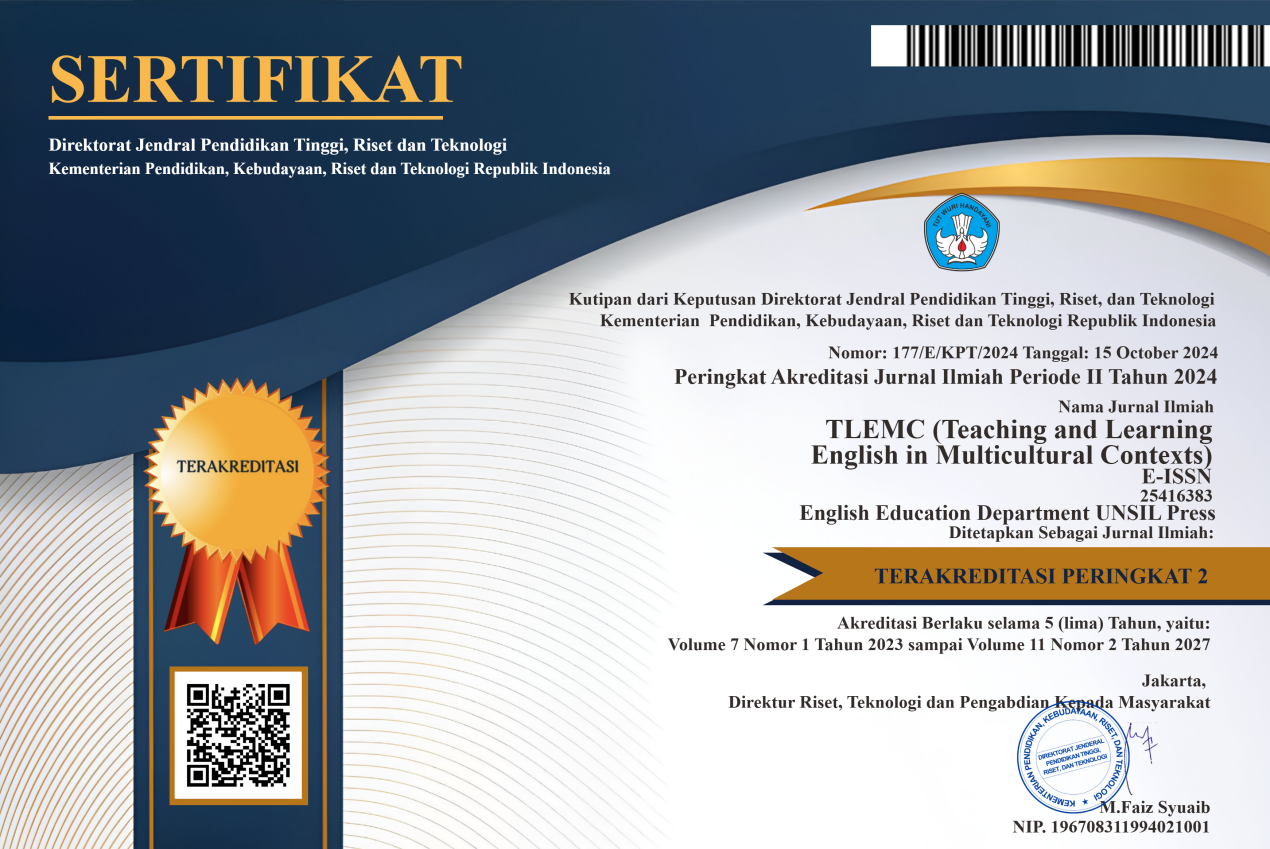Teacher's Perception of Students' Silence in EFL Classroom Context: A Case Study
Abstract
Numerous studies have investigated the phenomenon of students’ silence in the EFL classroom context. However, they are less attention in documenting the emergence of the teacher’s perception. Therefore, the present research aimed to dig the teacher’s perception and also seek the solution or teaching strategies that can be applied for encouraging silent students in the learning. The research is a case study and the data collection is using qualitative design through a semi-structured interview which involves a female teacher who has taught for about 30 years in one secondary school in Tasikmalaya. The data is analyzed thematically and the results showed that the teacher perceived the phenomenon of students’ silence into psychological aspects, students’ low self-motivation, and low self-confidence in language learning. The present research revealed that teacher’s perception influences all of the actions that applied in the classroom. The contributions are also viewed from the present study. They are teaching strategies such as integrated game-based learning (GBL), incorporated role-play, group presentation, and built a positive teacher-student relationship, and conducted external encouragement like appreciation. Those can be practiced by the teacher, novice teacher, or student-teacher particularly in dealing with the phenomenon of students’ silence itself.
Full Text:
PDFReferences
Abdullah, H. (2014). Attitudes and Motivation Toward Learning the English Language Among Students From Islamic Education System Background: Exploring the Views of Teacher. Edusentris, 1(3), 299. https://doi.org/10.17509/edusentris.v1i3.153
Alizadeh, M. (2016). The Impact of Motivation on English Language Learning. International Journal of Research in English Education, 1 (1), 11-15
Bligh, C. (2014). The silent experiences of young bilingual learners: A sociocultural study into the silent period. In The Silent Experiences of Young Bilingual Learners: A Sociocultural Study into the Silent Period. https://doi.org/10.1007/978-94-6209-797-1
Bligh, C., Drury, R., & Drury, R. (2016). Perspectives on the “ Silent Period †for Emergent Bilinguals in England Perspectives on the “ Silent Period †for Emergent Bilinguals in England. 8543(March). https://doi.org/10.1080/02568543.2015.1009589
Bower, K., & Bower, K. (2017). Explaining motivation in language learning : a framework for evaluation and research evaluation and research. The Language Learning Journal, 0(0), 1–17. https://doi.org/10.1080/09571736.2017.1321035
Braun, V., & Clarke, V. (2012). Thematic analysis. 2. https://doi.org/10.1037/13620-004
Choi, J. Y. (2015). Reasons for silence: A case study of two Korean students at a U.S. graduate school. TESOL Journal, 6(3), 579–596. https://doi.org/10.1002/tesj.209]
Coplan, R. J., Hughes, K., Bosacki, S., & Rose-krasnor, L. (2011). Is Silence Golden ? Elementary School Teachers ’ Strategies and Beliefs Regarding Hypothetical Shy / Quiet and Exuberant / Talkative Children. 103(4), 939–951. https://doi.org/10.1037/a0024551
Drugli, M. B., & Hjemdal, O. (2013). Factor Structure of the Student-Teacher Relationship Scale for Norwegian School-age Children Explored with Confirmatory Factor Analysis. Scandinavian Journal of Educational Research, 57(5), 457–466. https://doi.org/10.1080/00313831.2012.656697
Drury, R. (2013). European Early Childhood Education How silent is the “ Silent Period †for young bilinguals in early years settings in England ? (October 2014), 37–41. https://doi.org/10.1080/1350293X.2013.814362
Griskell, H. L., Gámez, P. B., & Lesaux, N. K. (2020). Learning and Individual Di ff erences Assessing middle school dual language learners ’ and English-only students ’ motivation to participate in classroom discussion. Learning and Individual Differences, 77(October 2019), 101799. https://doi.org/10.1016/j.lindif.2019.101799
Grolnick, W. S. (2009). in Education. https://doi.org/10.1177/1477878509104321
Harumi, S. (2011). Classroom silence: Voices from Japanese EFL learners. ELT Journal, 65(3), 260–269. https://doi.org/10.1093/elt/ccq046
Jin, J. (2017). Students ’ silence and identity in small group interactions. Educational Studies, 5698(May), 1–15. https://doi.org/10.1080/03055698.2016.1277135
Jones, V. N., & Conner, L. R. (2020). Measuring social work students reflective learning through role-play and writing. Social Work Education, 00(00), 1–11. https://doi.org/10.1080/02615479.2020.1729721
Juniati, S. R. (2018). Students ’ silence in the EFL speaking classroom. (July), 90–94.
Kafai, Y. B., Burke, Q., Kafai, F. Y. B., & Kafai, Y. B. (2016). Constructionist Gaming : Understanding the Benefits of Making Games for Learning Constructionist Gaming : Understanding the Benefits of Making Games for Learning. 1520(March). https://doi.org/10.1080/00461520.2015.1124022
Khan, M. (2015). Teachers ’ Perception of Students ’ Learning and Their Teaching in. (January).
Kilgour, P. W., Reynaud, D., Northcote, M. T., & Shields, M. (2015). Role-Playing as a Tool to Facilitate Learning, Self Reflection and Social Awareness in Teacher Education. International Journal of Innovative Interdisciplinary Research Retrieved from International Journal of Innovative Interdisciplinary Research, 2(2), 8–20. Retrieved from http://www.auamii.com/jiir/Vol-02/issue-04/2Kilgour.pdf
Kim, Y., Mok, S. Y., & Seidel, T. (2020). Parental influences on immigrant students’ achievement-related motivation and achievement: A meta-analysis. Educational Research Review, 30, 100327. https://doi.org/10.1016/j.edurev.2020.100327
Liao, Y. H., Chen, Y. L., Chen, H. C., & Chang, Y. L. (2018). Infusing creative pedagogy into an English as a foreign language classroom: Learning performance, creativity, and motivation. Thinking Skills and Creativity, 29, 213–223. https://doi.org/10.1016/j.tsc.2018.07.007
Liu, J. (2002). Negotiating silence in american classrooms: Three chinese cases. Language and Intercultural Communication, 2(1), 37–54. https://doi.org/10.1080/14708470208668074
Mahmud, M. (2017). Communicative Styles of English Stu
dents at the State University of Makassar. 17(February), 223–238.
Marengo, D., Jungert, T., Iotti, N. O., Settanni, M., Longobardi, C., Marengo, D., … Settanni, M. (2018). Conflictual student – teacher relationship , emotional and behavioral problems , prosocial behavior , and their associations with bullies , victims , and bullies / victims. Educational Psychology, 0(0), 1–17. https://doi.org/10.1080/01443410.2018.1481199
Medaille, A., Usinger, J., Medaille, A., & Usinger, J. (2019). Engaging Quiet Students in the College Classroom Engaging Quiet Students in the College Classroom. College Teaching, 0(0), 1–8. https://doi.org/10.1080/87567555.2019.1579701
Min, H. (2016). A Study on Silence Phenomenon in College English Classroom. International Journal of Education and Research, 4(6), 451–458. Retrieved from www.ijern.com
Nakane, I. (2006). Silence and politeness in intercultural communication in university seminars. Journal of Pragmatics, 38(11), 1811–1835. https://doi.org/10.1016/j.pragma.2006.01.005
Ollin, R. (2008). Silent pedagogy and rethinking classroom practice : structuring teaching through silence rather than talk. 38(2), 265–280. https://doi.org/10.1080/03057640802063528
Parrish, A., & Lanvers, U. (2018). Student motivation , school policy choices and modern language study in England. The Language Learning Journal, 0(0), 1–18. https://doi.org/10.1080/09571736.2018.1508305
Sadeghi, K., & Soleimani, M. (2016). The relationship between anxiety, shyness, ambiguity tolerance, and language learning strategies. International Journal of Pedagogies and Learning, 11(1), 70–87. https://doi.org/10.1080/22040552.2016.1187652
Sardone, N. B., & Devlin-scherer, R. (2016). The Clearing House : A Journal of Educational Strategies , Let the ( Board ) Games Begin : Creative Ways to Enhance Teaching and Learning Let the ( Board ) Games Begin : Creative Ways to Enhance Teaching and Learning ABSTRACT. The Clearing House, 89(6), 215–222. https://doi.org/10.1080/00098655.2016.1214473
Saylag, R. (2014). An Exploration on the Silence in the Classroom within a Diagnostic Perspective: Whose Silence is this? Procedia - Social and Behavioral Sciences, 114, 527–532. https://doi.org/10.1016/j.sbspro.2013.12.741
Schultz, K. (2010). After the Blackbird Whistles : Listening to Silence in Classrooms. 112(11), 2833–2849.
Shelton-strong, S. J., Mynard, J., & Mynard, J. (2020). Promoting positive feelings and motivation for language learning : the role of a confidence- building diary the role of a con fi dence-building diary. Innovation in Language Learning and Teaching, 0(0), 1–15. https://doi.org/10.1080/17501229.2020.1825445
Somers, T., & Llinares, A. (2018). Students’ motivation for content and language integrated learning and the role of programme intensity. International Journal of Bilingual Education and Bilingualism, 0(0), 1–16. https://doi.org/10.1080/13670050.2018.1517722
Spodek, B. (2016). Thought processes underlying preschool teachers ’ classroom decisions. 4430(June). https://doi.org/10.1080/0300443870290207
Stevens, R. (2015). Role-play and student engagement: reflections from the classroom. Teaching in Higher Education, 20(5), 481–492. https://doi.org/10.1080/13562517.2015.1020778
Sulistiyo, U. (2016). English Language Teaching and Efl Teacher Competence in Indonesia. Igniting a Brighter Future of EFL Teaching and Learning in Multilingual Societies, 4(2), 396–406. Retrieved from http://ejournal.unp.ac.id/index.php/selt/article/view/7001/5535
Tatar, S. (2009). Language and Intercultural Communication Why Keep Silent ? The Classroom Participation Experiences of Non-native- English-speaking Students Why Keep Silent ? The Classroom Participation Experiences of Non-native-English-speaking Students. (December 2014), 37–41. https://doi.org/10.1080/14708470508668902
Tsigilis, N., Gregoriadis, A., & Grammatikopoulos, V. (2017). Research Papers in Education Evaluating the Student – Teacher Relationship Scale in the Greek educational setting : an item parcelling perspective Evaluating the Student – Teacher Relationship Scale in the Greek educational setting : an item parcelling pe. Research Papers in Education, 1522(September), 1–13. https://doi.org/10.1080/02671522.2017.1353675
Wang, C., Swearer, S. M., Lembeck, P., Collins, A., Berry, B., Wang, C., … Berry, B. (2016). Teachers Matter : An Examination of Student- Teacher Relationships , Attitudes Toward Bullying , and Bullying Behavior Teachers Matter : An Examination of Student-Teacher Relationships , Attitudes. 7903(March). https://doi.org/10.1080/15377903.2015.1056923
Zhang, H., & Whitebread, D. (2019). Identifying characteristics of parental autonomy support and control in parent – child interactions. Early Child Development and Care, 0(0), 1–14. https://doi.org/10.1080/03004430.2019.1621303
DOI: https://doi.org/10.37058/tlemc.v5i1.2788
Refbacks
- There are currently no refbacks.
INDEXED BY:
This work is licensed under a Creative Commons Attribution-NonCommercial-ShareAlike 4.0 International License.
![]()
TLEMC (Teaching and Learning English in Multicultural Contexts)
Program Studi Pendidikan Bahasa Inggris
Fakultas Keguruan dan Ilmu Pendidikan
Universitas Siliwangi
Jl. Siliwangi No. 24 Kota Tasikmalaya - 46115
email: tlemc@unsil.ac.id





